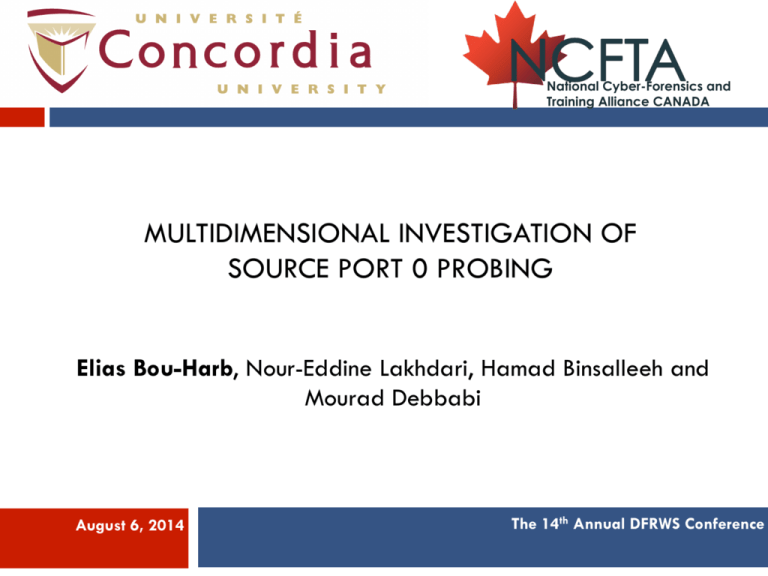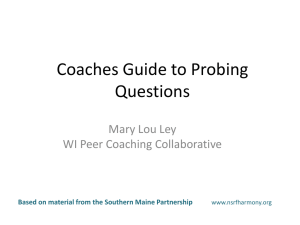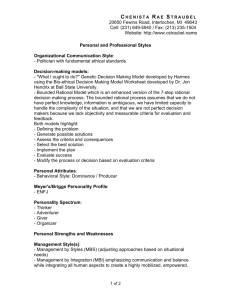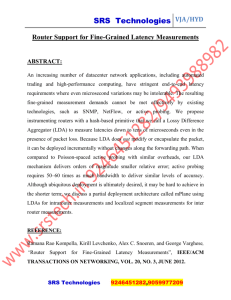pres - DFRWS
advertisement

National Cyber-Forensics and Training Alliance CANADA MULTIDIMENSIONAL INVESTIGATION OF SOURCE PORT 0 PROBING Elias Bou-Harb, Nour-Eddine Lakhdari, Hamad Binsalleeh and Mourad Debbabi August 6, 2014 The 14th Annual DFRWS Conference Motivation 2 Motivation 3 Motivation 4 Attacks on cyber physical systems rose 52% in 2013 ¨ The surge of severe DDoS attacks ¨ Motivation 5 Daily tens of thousands of threats (NCFTA Canada 2014) Motivation 6 ¨ Probing: n Scan organizational networks or Internet wide services Primary stage of an intrusion attempt n Facilitates more than 50% of cyber attacks n ¨ Large-scale orchestrated probing campaigns The event 7 Traffic originating from TCP source port 0 ¨ Investigated on November 24th and 25th, 2014 ¨ Inferred & Validated by Internet Storm Center (ISC) Objectives 8 ¨ Investigate the nature of such unprecedented increase of traffic originating from source port 0 ¨ Infer the maliciousness of the sources ¨ Attribute the event to a certain malware infection Approach 9 Darknet Analysis Passive DNS Correlation Malware Data Correlation Darknet 10 Passive DNS 11 Approach 12 Darknet Analysis Passive DNS Correlation Malware Data Correlation q Traffic Extraction by filtering traffic that employs TCP source port 0 q Misconfiguration Filtering to exclude darknet noise q Traffic Fingerprinting to distinguish between probing and backscattered traffic q Traffic Clustering to reveal sources possessing similar traffic patterns q Behavioral Analytics to infer the strategies, natures and mechanisms of the sources Traffic Fingerprinting Technique 13 ¨ Observation: n Probing techniques (TCP SYN, UDP, ACK, etc.) demonstrate a similar temporal correlation and similarity when generating their corresponding probing traffic Traffic Fingerprinting Technique 14 ¨ Detrended Fluctuation Analysis (DFA) To determine the statistical self-affinity of a signal n Excessively used in medicine, economy and geology n 2 works related to cyber security, none related to probing n ¨ The fluctuations are characterized by a scaling exponent α: - α < 0.5: anti-correlated - α ≈ 0.5: uncorrelated or white noise - α > 0.5: correlated - α ≈ 1: 1/f-noise or pink noise - α > 1: non-stationary, random walk like, unbounded - α ≈ 1.5: Brownian noise Traffic Fingerprinting Technique 15 Traffic Fingerprinting Technique 16 Start Does St refer to probing Traffic Time Series St Algorithm 1 Yes Inferred Probing Time Series Algorithm 2 Starting Location Inferred Probing Technique DFA Probing Distributions No Traffic Fingerprinting Technique 17 Start Does St refer to probing Traffic Time Series St Algorithm 1 Yes Inferred Probing Time Series Algorithm 2 Starting Location Inferred Probing Technique DFA Probing Distributions No Traffic Clustering 18 Behavioral Analytics 19 Statistical, heuristical, entropy, fuzzy hashing techniques Is the probing traffic random or does it follow a certain pattern? ¨ How are the targets being probed? ¨ What is the nature of the probing source? ¨ Is the probing targeted or dispersed? ¨ Darknet Inferences 20 ¨ Peak: n Generating more than 1 million packets n Similar traffic from other days is less than 1000 packets n 97% of traffic refer to probing activities ¨ Overlapping observations by ISC and NCFTA: n The TTL of the packets changes with source IP address n Packets with a TCP header length of 0 or packets with odd flag combinations (i.e., URG, PSH, Reserved) n The packets arrival rate is slow, way far from DDoS levels n Xmas Tree-like probing in most TCP flags Darknet Inferences: Probing Sources 21 ¨ Originating from ¤ 27 unique sources ¤ 17 countries ¤ 24 ISPs ¤ 25 organizations Darknet Inferences: Probing Sources 22 IP concentration Darknet Inferences: Targeted Ports 23 ¨ Port 0 from X.X.X.163, the sole German IP: 813 thousand packets/destinations ¨ Port 445: 8952 packets ¨ Port 22: 7080 packets ¨ Port 3389: 5606 packets ¨ > 60,000 ports from X.X.X.201, the sole Dutch IP Darknet Inferences: Traffic Similarity 24 ¨ ¨ ¨ ¨ One cluster for the horizontal scan on port 0 from the German IP Another cluster for the horizontal scan on > 60 thousand ports from the Dutch IP Another cluster for probing on other ports such as 445, 22 and 3389 Last cluster represents misconfigurations/malformed packets Darknet Inferences: Behavioral Analytics 25 ¨ Probing clusters 1 and 2: ¤ random probing traffic as opposed to using patterns ¤ sequential strategy ¤ probing tool ¨ Probing cluster 3: ¤ pattern usage ¤ permutation strategy ¤ bots Approach 26 Darknet Analysis Passive DNS Correlation Malware Data Correlation q Hosting capability to infer malicious domains affiliated with the sources q Intensity to detect accessibility and involvement q Aliveness to verify the effectiveness of the malicious domains Passive DNS Inferences 27 q 513 to 110 thousand hosted domains per the probing IPs q 28% of the probing IPs are hosting blacklisted/malicious domains Passive DNS Inferences 28 Half of the malicious domains could be attributed to malware activities Passive DNS Inferences 29 q Some malicious domains are very effective; high access count and low active days q Domains with prolonged active days provide back-end services to others malicious activities Approach 30 Darknet Analysis Passive DNS Correlation Malware Data Correlation q Machine infection to deduce malware samples that infect the sources q Malware Attribution to infer the malware samples that generate such traffic Malware Inferences 31 Virus.Win32.Sality is the common factor Summary 32 ¨ ¨ ¨ Traffic is indeed reconnaissance/probing activities originating from three different horizontal scans 28% of the scanning sources host malicious/blacklisted domains as they are often used for spamming, phishing and other fraud activities Bot probing sources (i.e., probing cluster 3) are infected by Virus.Win32.Sality Outcome 33 ¨ ¨ Devised a generic approach that could be applied to analyze other cyber events with similar nature Demonstrated the value added of employing ¤ Databases of cyber security data (darknet, passive dns and malware) ¤ Tools and APIs that can effectively utilize the data ¨ Permitted prompt data analysis to support investigation of cyber events Acknowledgement 34 ¨ ¨ Research members of the NCFTA Canada lab headed by Prof. Mourad Debbabi Natural Sciences and Engineering Research Council of Canada (NSERC) Questions Elias Bou-Harb Ph.D. Candidate Cyber Security R&D e_bouh@encs.concordia.ca









